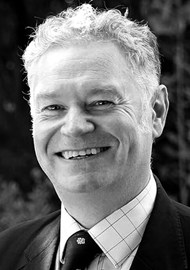In this series of articles I am going to show you some of the exhibits contained in the Museum of Urology, hosted on the BAUS website (www.baus.org.uk).
To urologists, the name Dietl is linked with the eponym of Dietl’s crisis, loin pain after a fluid load. However, my friend and colleague, Aneta Obloza, on hearing the name of her countryman, thought instead of balneology, natural thermal water treatment and the city of Krakow; clearly a topic for the Urology News History column to investigate!

Figure 1: Józef Dietl as depicted on a 1957 Polish postage stamp.
Józef Konrad Dietl (Figure 1) was born on 24 January 1804 in Podbuże, a village which at that time was part of the Austro-Hungarian Empire, previously part of Polish Galicia (it is now in Ukraine). His Austrian father, Francisco, was a clerk to a local landowner and it is said his mother Anna Kulczycka was descended from Polish nobility. Unfortunately, his father died in 1819 so Jozef was forced to tutor other students in order to pay for his own education. He read philosophy at the University of Lviv from 1821 to 1823 when he moved to Vienna to study medicine (continuing to pay his way by acting as a private tutor). His medical thesis of 1829, ‘Dissertatio inauguralis medica sistens quedam circa medicinae securitatem’ or ‘Some words about the credibility of health science especially worth remembering for non-physicians’, essentially stated that patients were no longer impressed by the poor results of doctors’ treatments.
Dietl the clinical scientist
This somewhat unusual topic was the warning shot of his lifelong thesis of challenging accepted and out of date medical practices. Dietl believed that recovery from illness depended more on the forces of nature than the role of the physician who was not required to produce miracle cures, but rather to support the natural forces of the body. The physician, he said, had been for too long a mere Heilkilnstler (therapist) and should instead strive to become a Naturforscher (scientific researcher). With Carl von Rokitansky (1804-1878) and Joseph Skoda (1805-1881), he co-created the movement known as the Second Vienna School of Medicine, which was characterised by therapeutic scepticism or indeed nihilism and scientific radicalism and rationalism.
Dietl was a pioneer of evidence-based medicine as we now know it. In 1849, he published a clinical trial arguing against the ancient practice of bleeding in cases of pneumonia. Of 380 cases, 85 were treated by bloodletting, 106 by large doses of tartar emetic to induce vomiting and the rest by diet and rest alone. 20.4% of those bled died, as did 20.7% of those purged; of those cared for by rest and careful diet only 7.4% died. Initially, his research was not well received but eventually, through this scientific clinic trial, he was instrumental in ending the practice of bleeding in pneumonia.

Figure 2: A 19th century kołtun or plica polonica in Jagiellonian
University History of Medicine Department, author’s photograph.
Dietl was also responsible for ridding the world of the folklore superstition of the kołtun or plica polonica (the Polish plait) (Figure 2). There was a belief that this smelly mass of unkempt, insect-ridden and unwashed hair was a disease (rather than a neglect in personal hygiene) but also that to cut off this kołtun may lead to worse diseases including paralysis, blindness and death. Despite significant objections from those who held strong superstitious beliefs; he managed to eradicate the kołtun as both a disease and a potential source of one.
After qualification, Dietl was offered the position of demonstrator in the Department of Mineralogy and Zoology at the University of Vienna. In 1830, he was delegated by the government to help in the control of the cholera epidemics in Vienna. He did well and was made director of Vienna’s largest cholera hospital in 1832. He failed to gain a post in Padua so set up in practice in the Wieden district on the outskirts of Vienna taking an honorary position in the hospital there; his practice flourished.
Dietl, as an internist, focused on diagnostics. Thanks to his forward approach, recognising there was no effective therapy without a soundly made diagnosis, he introduced auscultation and percussion as an essential part of medical assessment. His motto was “exact examination and simple treatment”. His efforts also led to the formation of dissecting rooms in medical schools, as he believed that knowledge of human anatomy alongside principles of physiology help to understand the origins of disease. Furthermore, he helped to create laboratory analytics as an adjunct to modern diagnostics. On 12 May 1851, Dietl took over the Department of Pathology and Specific Therapy and the Medical Clinic as Professor of Internal Medicine at the Jagiellonian University of Krakow.
Dietl the politician
At Jagiellonian University he was Professor (1851-1865), Dean (1856-1861) and also Rector (1861-1862). Whilst there, Dietl was an outspoken advocate of educational reform and Polish nationalism. He campaigned for an increase in the number of schools, for improved circumstances of teachers and was a fervent proponent of comprehensive education for girls. He also called for an end to the teaching of school children in German and at the university initiated the translation of medical handbooks into Polish. These were printed at the University and sold at very low prices.
Unfortunately, this patriotic but anti-Austrian activity did not bode well with the government, and on 14 June 1865, the Emperor Franz Joseph signed an order to retire Dietl from the Jagiellonian; no official reason was given. However, the following year saw the introduction of Galician autonomy, and the City Council of Krakow elected Dietl as the new Mayor, an office he held for eight years. In a happy ending to this part of the story, in 1869, Dietl organised a magnificent reception for Emperor Franz Joseph to thank him for restoring the Polish language to the Galician population in schools and in the civil service. In return, the Emperor appointed Dietl a life member of the Austrian Upper House.
Dietl’s term in office as Mayor of Krakow had an overriding aim to make Krakow a clean, healthy and ornate city. One wonders whether the return of his young wife, Helena Zieterbarth, to the more sophisticated Vienna influenced Dietl’s political axis. His many endeavours resulted in significant melioration works including paved streets, better street lighting and developments to the sewage system leading to better water supply and a reduced risk of cholera.
Dietl’s aesthetic streak, alongside with his leadership and management skills, led to renovation and restoration of the famous trade centre, Sukiennice, in the heart of the city, as well as the opening of the Cygarfabryki (tobacco factory). His reformation of the city council led to a doubling of the city’s income by the end of his tenure. He also made plans to restore Planty, the largest park in the city of Krakow, to a place to relax and take recreational strolls.
Dietl’s crisis
Dietl was an ardent educator whose aim was to teach methodology of making a diagnosis which was based on observations, examination including cadaveric dissection and chemical analysis across all body systems. It was followed by logical conclusions about prognosis and management plans. Dietl’s crisis is described as episodic, crampy upper abdominal pain, nausea and vomiting often during periods of increased fluid intake. Pain is due to intermittent renal pelvis dilation secondary to delayed ureteric drainage associated with intermittent renal pelvi-ureteric junction (PUJ) obstruction. This may be due to an aberrant crossing vessel, high insertion of the ureter into the pelvis or congenital narrowing. Dietl described this symptom complex in a paper in the Wiener Medizinische Wochenschrift on Sunday 17 September 1864 called ‘Wandernde Nieren and deren einklemmung’ or ‘The wandering and trapped kidney’. Rather than congenital PUJ obstruction, which we associate with Dietl’s crisis, its original description was in association with nephroptosis or floating kidney. The kidney ‘fell’ and caused a kink in the ureter. His treatment was to lie the patient down and then support the kidney with belts and straps. From the 1870s onwards operative treatment was recommended to fix the wandering organ.
Dietl and the spas
In the years 1854-1858 Dietl visited most health resorts and spas in Europe; in 1857 alone, Dietl visited 10 Polish health resorts. Thermal waters were known in Poland since the 13th century. The town of Cieplice was the most popular amongst Polish nobility and celebrities including the composer Fryderyk Chopin. In the 19th century, the spa in Krynica saw the origins of balneology thanks to Jozef Dietl. Dietl recommended the waters of Zdrój Glówny in Krynica to women suffering from anaemia and chlorosis, and to patients with “chronic inflammation of the bladder and kidney and with skin eruptions”. He classified the Polish therapeutic springs and described detailed prescriptions for spa treatment insisting that ‘taking the waters’ or balneotherapy, later called hydrotherapy, alone was not enough and treatment should include diet and physiotherapy.
Dietl, along with Józef Majer (1808-1899) and Fryderyk Skobel (1806 -1878), created the Balneology Association in 1857 whose members included doctors, chemists, physicists, geologists and construction representatives. Its goal was to promote and develop national thermal water spas, quality assessment of thermal waters, policing their exploitation and correct bottling, and finally, observation of meteorologic factors on therapy efficacy.
Józef Dietl died on 18 January 1878. His resplendent funeral was paid for by the city of Krakow. The lasting memory of Dietl is still alive in Krakow as an outstanding mayor, patriot and propagator of Polish culture, having a major street and hospital named after him. His prolific endeavours left Krakow in much higher standing. Dietl’s scientific approach to disease led to a paradigm shift from medicine being an art to being a scientifically based study of a disease and its treatment as a result of in-depth knowledge. He was one of the original proponents of balneology and other therapies using a hygienic and dietetic approach. His monument was erected in 1938 at the All-Saints Place next to the City Council to commemorate the 60th anniversary of his death. He is known as a philanthropist, educator and medic. He was awarded the highest Polish decorations and is buried in Rakowicki Cemetery in Krakow.
In his long and illustrious career, Józef Dietl was faced with the crisis of the remnants of ancient medical practices and medical superstitions, the crisis of the loss of the Polish language and culture, and even the loss of the grand Polish health spas. Dietl faced these crises and did what he could to remedy them but now, certainly in the UK, he is mainly remembered for his eponymous legacy.








